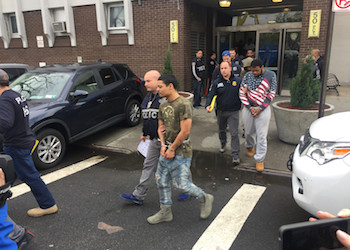Authorities say the majority of some 20 gang members detained in the Bronx neighborhood of New York City last week were Dominican, shedding light on how the low profile of gang members from the Dominican Republic has allowed their powerful transnational links to be overlooked.
Known as the “Slut Gang” (“Pandilla Puta”), several of the organization’s members were arrested on April 20 and indicted on racketeering, narcotics, robbery, extortion and firearms offenses.
According to the indictment, the gang “sold narcotics, carried loaded guns, and committed acts of violence against rival gangs in the Bronx.”
The gang is just one of many operating in New York City, along with the Latin Kings, Bloods, Crips, Trinitarios and the MS13.
According to a 2011 police briefing obtained in 2013 by the New York Times, Dominican gangs were estimated to have more than 1,100 members in the city.
During the operation to arrest the Slut Gang members, authorities from the New York Police Department (NYPD), Drug Enforcement Administration (DEA) and the Department of Homeland Security (DHS) seized crack, heroin, ecstasy (MDMA) and marijuana, in addition to guns and ammunition.
Last year, authorities targeted two of the Slut Gang’s rivals, the Big Money Bosses (BMB) and 2Fly YGz (2Fly) gangs, in the “largest street gang takedown in New York City history.”
In an unrelated operation earlier this month, the Department of Homeland Security arrested one of its own agents for allegedly trying to help Dominican drug traffickers smuggle over 100 pounds of cocaine through New York’s John F. Kennedy international airport.
InSight Crime Analysis
Despite being often overlooked, organized crime groups in the Dominican Republic have powerful transnational links that have made them players in the international drug trade.
According to the DEA’s 2016 National Drug Threat Assessment, transnational crime groups in the Dominican Republic do in fact “pose a threat” to the United States, though not as much as their Mexican and Colombian counterparts.
US-based Dominican organized crime groups primarily operate on the East Coast in cities like Philadelphia, Boston and New York. These groups receive “direct supplies of cocaine and heroin” from local groups in the Dominican Republic that work “directly with Colombian sources of supply,” the DEA report states.
The DEA also notes that Colombian and Mexican drug trafficking groups rely on Dominican networks to “transport and distribute” drugs at the retail level in the United States. These groups often dominate the local drug trade as a result. For example, the DEA report states that Dominican traffickers are the “dominant retail distributors of cocaine” in the metropolitan area of New York City.
In response, Dominican and US authorities are increasing collaborative efforts to fight drug trafficking and other forms of organized crime. One of these measures is the Caribbean Basin Security Initiative, a regional effort by the United States Southern Command (SOUTHCOM), the Dominican National Drug Control Directorate (Dirección Nacional de Control de Drogas – DNCD) and the Dominican armed forces to “substantially reduce illicit trafficking.”
SEE ALSO: Coverage of the Dominican Republic
While US President Donald Trump has promised to ramp up deportations of suspected gang members — particularly those of the MS13 — this is unlikely to have much impact on Dominican gangs’ operations. Whereas deported MS13 members often return to El Salvador and re-establish the “clicas” and structures they formed in the United States, the Dominican Republic has not developed a similar problem. Rather, an intelligence source in the Dominican Republic told InSight Crime that Dominican gang members deported from the United States often become involved in transnational criminal activities, particularly drug trafficking.
The Dominican Republic’s role in the drug trade is significant, and appears poised to grow in importance. During a recent trip to the capital Santo Domingo, Vice Admiral Félix Pimental, the head of the DNCD suggested to InSight Crime that up to 120 tons of cocaine were passing through the island every year, a huge percentage of which goes to Europe. This is an extraordinary amount of drugs, equivalent to about 15 percent of annual global cocaine production.
And as in the United States, Dominican crime groups play an important role in the trafficking and distribution of drugs in Europe.
In 2014, Spanish news outlet ABC described the Trinitarios, a Dominican gang operating in Madrid, as “the most dangerous gang” in the city. Indications of violent Dominican gang activity in Madrid have continued to surface in the years since.
The Trinitarios are also reportedly active in Italy. Last year a murder in Milan reportedly involving the Trinitarios prompted authorities to request that 250 soldiers be deployed to the area. According to news service Agenzia Giornalistica Italia, there has been a “bloody gang war” for several years among the Barrio 18, MS13 and Trinitarios over drug trafficking operations in the city, highlighting the transnational reach of these criminal groups.

